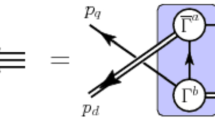Abstract
A symmetry preserving framework for the study of continuum Quantum Chromodynamics (QCD) is obtained from a truncated solution of the QCD equations of motion or QCD’s Dyson–Schwinger equations (DSEs). A nonperturbative solution of the DSEs enables the study of, e.g., hadrons as composites of dressed-quarks and dressed-gluons, the phenomena of confinement and dynamical chiral symmetry breaking (DCSB), and therefrom an articulation of any connection between them. It is within this context that we present a unified study of Nucleon, Delta and Roper elastic and transition electromagnetic form factors, and compare predictions made using a framework built upon a Faddeev equation kernel and interaction vertices that possess QCD-like momentum dependence with results obtained using a symmetry-preserving treatment of a vector \(\otimes \) vector contact-interaction. The comparison emphasises that experiment is sensitive to the momentum dependence of the running coupling and masses in QCD and highlights that the key to describing hadron properties is a veracious expression of DCSB in the bound-state problem.
Similar content being viewed by others
References
Aznauryan, I.G., et al.: Studies of nucleon resonance structure in exclusive meson electroproduction. Int. J. Mod. Phys. E 22, 1330015 (2013)
Tiator, L., et al.: Electroproduction of nucleon resonances. Eur. Phys. J. A 19, 55 (2004)
Kamano, H., et al.: Nucleon resonances within a dynamical coupled-channels model of \(\pi N\) and \(\gamma N\) reactions. Phys. Rev. C 88, 035209 (2013)
Cloët, I.C., et al.: Revealing dressed-quarks via the proton’s charge distribution. Phys. Rev. Lett. 111, 101803 (2013)
Chang, L., et al.: Pion electromagnetic form factor at spacelike momenta. Phys. Rev. Lett. 111, 141802 (2013)
Segovia, J., et al.: Insights into the \(\gamma ^{\ast }N\rightarrow \varDelta \) transition. Phys. Rev. C 88, 032201 (2013)
Segovia, J., et al.: Elastic and transition form factors of the \(\varDelta (1232)\). Few Body Syst. 55, 1–33 (2013)
Segovia, J., et al.: Nucleon and \(\varDelta \) elastic and transition form factors. Few Body Syst. 55, 1185–1222 (2014)
Segovia, J., et al.: Understanding the nucleon as a Borromean bound-state. Phys. Lett. B 750, 100–106 (2015)
Segovia, J., et al.: Completing the picture of the Roper resonance. Phys. Rev. Lett. 115, 171801 (2015)
Chang, L., et al.: Selected highlights from the study of mesons. Chin. J. Phys. 49, 955–1004 (2011)
Bashir, A., et al.: Collective perspective on advances in Dyson–Schwinger equation QCD. Commun. Theor. Phys. 58, 79–134 (2012)
Cloët, I., et al.: Explanation and prediction of observables using continuum strong QCD. Prog. Part. Nucl. Phys. 77, 1–69 (2014)
Olive, K.A., Particle Data Group, et al.: The review of particle physics. Chin. Phys. C 38, 090001 (2014)
Mokeev, V.I., et al.: Experimental study of the \(P_{11}(1440)\) and \(D_{13}(1520)\) resonances from CLAS data on \(ep\rightarrow e^{\prime }\pi ^{+}\pi ^{-}p^{\prime }\). Phys. Rev. C 86, 035203 (2012)
Mokeev, V.I., et al.: Studies of \(N^{\ast }\) structure from the CLAS meson electroproduction data. Int. J. Mod. Phys. Conf. Ser. 26, 1460080 (2013)
Punjabi, V., et al.: Proton elastic form-factor ratios to \(Q^2 = 3.5\,{\rm GeV}^2\) by polarization transfer. Phys. Rev. C 71, 055202 (2005)
Puckett, A.J.R., et al.: Recoil polarization measurements of the proton electromagnetic form factor ratio to \(Q^2 = 8.5\,{\rm GeV}^2\). Phys. Rev. Lett. 104, 242301 (2010)
Puckett, A.J.R., et al.: Final analysis of proton form factor ratio data at \(Q^2 = 4.0\), \(4.8\) and \(5.6\,{{\rm GeV}}^2\). Phys. Rev. C 85, 045203 (2012)
Cates, G.D., et al.: Flavor decomposition of the elastic nucleon electromagnetic form factors. Phys. Rev. Lett. 106, 252003 (2011)
Jones, H.F., et al.: Multipole \(\gamma N\varDelta \) form-factors and resonant photoproduction and electroproduction. Ann. Phys. 81, 1–14 (1973)
Eichmann, G., et al.: Nucleon to Delta electromagnetic transition in the Dyson–Schwinger approach. Phys. Rev. D 85, 093004 (2012)
Beg, M.A.B., et al.: SU(6) and electromagnetic interactions. Phys. Rev. Lett. 13, 514–517 (1964)
Buchmann, A.J.: Electromagnetic \(N\rightarrow \varDelta \) transition and neutron form-factors. Phys. Rev. Lett. 93, 212301 (2004)
Carlson, Carl E.: Electromagnetic \(N-\varDelta \) transition at high \(Q^{2}\). Phys. Rev. D 34, 2704 (1986)
Aznauryan, I.: Results from the \(N^{\ast }\) program at JLab. J. Phys. Conf. Ser. 299, 012008 (2011)
Ash, W., et al.: Measurement of the \(\gamma NN^{\ast }\) form factor. Phys. Lett. B 24, 165–168 (1967)
Julia-Diaz, B., et al.: Extraction and interpretation of \(\gamma N\rightarrow \varDelta \) form factors within a dynamical model. Phys. Rev. C 75, 015205 (2007)
Sanchis-Alepuz, H., et al.: Pion cloud effects on baryon masses. Phys. Lett. B 733, 151–157 (2014)
Aznauryan, I.G., et al.: Electroexcitation of nucleon resonances from CLAS data on single pion electroproduction. Phys. Rev. C 80, 055203 (2009)
Aznauryan, I.G., et al.: Electroexcitation of nucleon resonances. Prog. Part. Nucl. Phys. 67, 1–54 (2012)
Alexandrou, C., et al.: Evidence for diquarks in lattice QCD. Phys. Rev. Lett. 97, 222002 (2006)
Eichmann, G., et al.: Nucleon mass from a covariant three-quark Faddeev equation. Phys. Rev. Lett. 104, 201601 (2010)
Gayou, O., et al.: Measurements of the elastic electromagnetic form-factor ratio \(mu_p G_{Ep}/G_{Mp}\) via polarization transfer. Phys. Rev. C 64, 038202 (2001)
Dugger, M., et al.: \(\pi ^+\) photoproduction on the proton for photon energies from \(0.725\) to \(2.875\,{\rm GeV}\). Phys. Rev. C 79, 065206 (2009)
Suzuki, N., et al.: Disentangling the dynamical origin of \(P_{11}\) nucleon resonances. Phys. Rev. Lett. 104, 042302 (2010)
Eichmann, G., et al.: Perspective on rainbow-ladder truncation. Phys. Rev. C 77, 042202 (2008)
Eichmann, G., et al.: Toward unifying the description of meson and baryon properties. Phys. Rev. C 79, 012202 (2009)
Author information
Authors and Affiliations
Corresponding author
Additional information
This article belongs to the special issue “Nucleon Resonances”.
Rights and permissions
About this article
Cite this article
Segovia, J. \(\mathbf {\gamma _{v} NN^{*}}\) Electrocouplings in Dyson–Schwinger Equations. Few-Body Syst 57, 993–1000 (2016). https://doi.org/10.1007/s00601-016-1140-y
Received:
Accepted:
Published:
Issue Date:
DOI: https://doi.org/10.1007/s00601-016-1140-y




